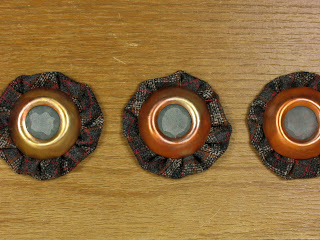First, I think some information about me is necessary. I'm somewhat of a hypochondriac. Not totally, but only because I know what's going on and I have the ability to talk myself out of whatever I think I have. I'm not really concerned about germs and colds and normal things like this, ohhh no. I become terrified that I have weird things, like receding gums and tetanus. When I first began taking metals, I didn't get a tetanus vaccination because the doctor said I really didn't need one, since I was working with non-ferrous metals. Even though I do come into contact with steel in the form of tools and such, the doctor still said I didn't need it. But I spent the whole semester convinced that I had tetanus. Any time I got a little cut or scrape, I would freak out and go to the health clinic on campus. I remember one night I couldn't sleep because I kept thinking my knees were locking up, then I would jump up and run to the mirror (which i wouldn't have been able to do if my knees were in fact locking up...I realize) to see if my face was doing the weird muscular contortions that are associated with tetanus. I finally went to the doctor and insisted I get vaccinated just to ease my mind, and I still freak out sometimes and have to remind myself that tetanus innoculations are good for 10 years. When I eat fish, I have to consciously remind myself that I do not, nor have I ever had an allergy to fish or seafood. I begin to freak out and think my throat is closing up. I manage to control it, and I eat fish all the time, but there's always that moment where I have to stop and just have a conversation with myself.
When I was doing my undergraduate studies (in Psychology), I took a class about sensory perception with Dr. Scharff. I loved that class and I thought it was so interesting! The whole class was about the senses and the brain, and how they interact. We spent over half the semester on vision alone. It was so fascinating, but terrifying at the same time. So many things can go wrong with your vision, and sometimes (well, before we started all this testing when children are young) you could have one of these disorders your whole life and never realize it's abnormal. I spent the whole semester worried about my vision. I called my optomitrist so many times that the nurses would just stop transferring me.
So I thought it could be really interesting to make a pair of glasses that would show people what it would be like to have Hemianopia or Visual Neglect (two different names because you can experience this visual problem from two different sources). My hope was that people could see why they should be as terrified of these disorders as I am. I didn't want to just cut the glasses out of sheet metal because that would look cheap and be too easy. Even though I only had 2 weeks to do this, I decided to make the entire glasses a hollow-constructed form.
I patinated the front to indicate the point of trauma, and it ended up looking like an old, stained mirror. I don't mind that because I feel like it goes along with the idea of something being wrong.
The inside of the glasses is lined with sterling silver that I etched with nitric acid. I used designer glasses logos and cut them in half to help indicate to the viewer what will happen when they put the glasses on, but also to help intice people to put their face close to the glasses to look at the fine detail.
I put three coats of wax on the glasses to help keep the copper from getting blotchy like that, but I guess in this case that just wasn't enough. I will have to go back and sand off the blotches and re-wax.
I've decided to do a whole series on these weird things that scare me. I'm excited to see where it goes.








































